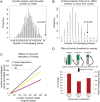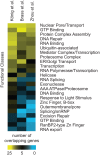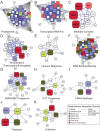Host cell factors in HIV replication: meta-analysis of genome-wide studies
- PMID: 19478882
- PMCID: PMC2682202
- DOI: 10.1371/journal.ppat.1000437
Host cell factors in HIV replication: meta-analysis of genome-wide studies
Abstract
We have analyzed host cell genes linked to HIV replication that were identified in nine genome-wide studies, including three independent siRNA screens. Overlaps among the siRNA screens were very modest (<7% for any pairwise combination), and similarly, only modest overlaps were seen in pairwise comparisons with other types of genome-wide studies. Combining all genes from the genome-wide studies together with genes reported in the literature to affect HIV yields 2,410 protein-coding genes, or fully 9.5% of all human genes (though of course some of these are false positive calls). Here we report an "encyclopedia" of all overlaps between studies (available at http://www.hostpathogen.org), which yielded a more extensively corroborated set of host factors assisting HIV replication. We used these genes to calculate refined networks that specify cellular subsystems recruited by HIV to assist in replication, and present additional analysis specifying host cell genes that are attractive as potential therapeutic targets.
Conflict of interest statement
The authors have declared that no competing interests exist.
Figures



References
-
- Rines DR, Tu B, Miraglia L, Welch GL, Zhang J, et al. High-content screening of functional genomic libraries. Methods Enzymol. 2006;414:530–565. - PubMed
-
- Brass AL, Dykxhoorn DM, Benita Y, Yan N, Engelman A, et al. Identification of host proteins required for HIV infection through a functional genomic screen. Science. 2008;319(5865):921–926. doi:10.1126/science.1152725. - PubMed
-
- Zhou H, Xu M, Huang Q, Gates AT, Zhang XD, et al. Genome-scale RNAi screen for host factors required for HIV replication. Cell Host Microbe. 2008;4(5):495–504. doi:10.1016/j.chom.2008.10.004. - PubMed

